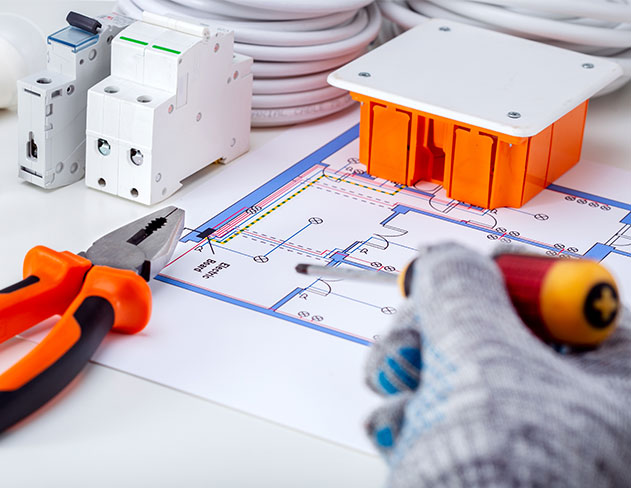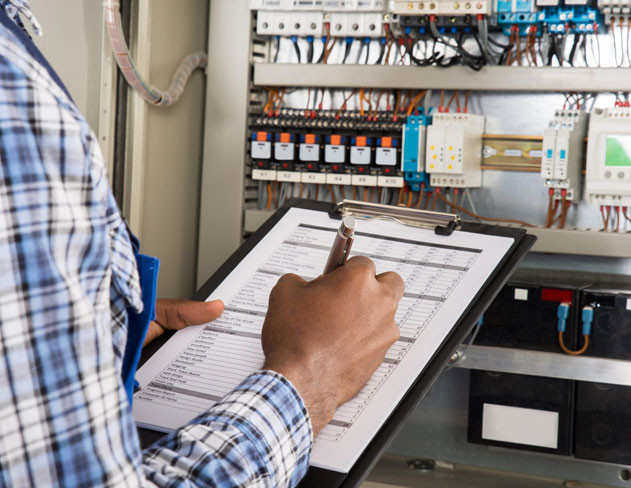EICR for Heritage Properties: Special Considerations
At Hexo Electrical Testing, we understand the unique requirements and regulations surrounding electrical work in historical buildings. As a leading specialist in commercial EICR services with years of experience, we frequently conduct electrical installation condition reports on sensitive heritage sites across the UK.
These properties require an alternative approach that balances safety, legal obligations, practical limitations, and aesthetic preservation. Outdated electrical components can pose serious hazards, yet upgrades must adhere to strict non-invasive standards that protect structural and decorative elements of historical value.
By the end, owners will better understand compliance duties, risks posed by outdated electrics, and work collaboratively with specialists to find solutions that prioritise occupant/property safety while respecting preservation regulations. Protecting irreplaceable history requires striking a considered balance.
The Importance of Electrical Safety in Heritage Properties
Electrical safety takes on heightened importance in heritage properties due to their age, historical components, and special legal protections. As structures that are sometimes hundreds of years old, they often have antiquated wiring systems that can pose serious risks if not properly maintained and updated. On average, homes in England and Wales were most commonly built between 1930 and 1982, (46% in England and 39% in Wales).
Outdated fuse boxes, deteriorating cabling, and circuits that have endured significant wear and tear over long periods of time have substantial potential to cause fires, shocks, and other dangerous electrical faults. The risks only increase if unqualified personnel attempt repairs without the proper training, tools, and methodologies suited for sensitive heritage sites.
On top of safety concerns, heritage buildings have special legal obligations regarding electrical work due to their listed status. Any upgrades or changes must adhere to regulations that preserve structural and decorative aspects of historical significance. Relevant governing bodies must provide consent before moving forward with projects that impact these facets. Failing adherence carries heavy consequences in the form of substantial fines.
The Role of Electrical Installation Condition Reports (EICRs)
Before diving deeper into the specifics around heritage properties, it is important to understand what an Electrical Installation Condition Report (EICR) entails generically.
Understanding (EICRs)
An EICR is an assessment conducted by a qualified electrician to evaluate the current state of a property’s complete electrical installation. It provides a detailed breakdown of the condition of all components, highlighting any damage, wear and tear, urgently needed repairs, or elements that fail to meet the latest regulatory standards.
Issues identified in EICRs must be addressed within a set timeframe based on the severity of the risks posed. Non-compliance can impact home insurance policies or result in legal action depending on the property type. For rental units or public buildings, updated satisfactory EICR reports may be mandatory as directed by governing organisations.
Definition and Purpose of an EICR
In addition to meeting safety and regulatory requirements through necessary upgrades, valid EICRs also provide longer-term benefits. Preventative maintenance surfaced through assessments can stop minor issues becoming major, expensive problems down the road. Enhanced efficiency from dated systems being brought up to current standards also typically yields cost savings from reduced energy consumption.
Legal Requirements and Obligations for Heritage Property Owners
Owners and operators of recognised heritage properties have additional legal obligations and restrictions regarding electrical work and EICRs compared to standard buildings. These special considerations originate from the standards and rules applied due to their historic status.
Unique Considerations for Heritage Properties
All modifications and repairs to electrical installations in listed buildings must adhere strictly to non-invasive methods that do not damage or permanently alter structural elements. Even seemingly minor changes like hanging new light fixtures can violate requirements that protect unique period designs or architectural themes. Restrictions extend to avoiding upgrades that undermine aesthetically important components related to electrical delivery systems.
Making updates solely based on modernising aged circuitry or improving efficiency is insufficient justification under heritage site rules without special approvals. All proposals for electrical work must explicitly guarantee no impairment to the preservation designation aspects will occur.
Additional paperwork and consent forms also enter the equation when registering electricians approved to conduct EICRs and associated repairs flagged for action. Governing agencies want extensive details on methodologies and materials vetted by oversight committees prior to authorising commencement.
Neglecting these heritage site regulations exposes owners to substantial fines and penalties for breach of compliance. Major legal and financial consequences can quickly accumulate.
Challenges Posed by Aged Electrical Systems
As established, heritage buildings require an alternative approach to electrical servicing and safety upgrades to account for their protected status. Balancing regulations, practical limitations, safety needs, and preservation aesthetics proves a tricky balancing act.
The advanced age of many heritage properties means electrical systems suffer more wear and tear issues over longer stretches of time. However, wiring and fuse box components can be extremely difficult to access let alone replace in historical buildings. Walls may contain priceless murals or ornamental designs that cannot be disturbed. Yet leaving hazardous electrics in clearly poses unacceptable risks.
Specialist electricians rely on non-invasive techniques like thermal imaging scans to identify problems areas behind walls or underground cables. We offer a thermal imaging survey to help identify unusual hot spots. Detailed documentation provides supporting rationale when proposing necessary but visually impactful changes to governing committees. Photos record site conditions before any invasive confirmation inspections that may still receive approval.
The ultimate work delivered must align to heritage directives around maintaining a property’s period styling. Upgrades focus on safety and regulation compliance rather than modernisation. If newer electrical components get approved as essential for hazard protection, they install discreetly. All efforts made avoid permanent impacts to aesthetics or forced removals /alterations of original historic elements.
Balancing preservation with safety enhancements
When electrical issues arise in heritage sites, owners must ensure they hire appropriately qualified electricians to handle inspections, repairs, and upgrades. Specialist expertise proves essential to properly navigate obligations around preservation and invasiveness.
Ideally electricians hold certification from recognised industry bodies like the NICEIC and ECA. This guarantees extensive training, adherence to regulations, and mandated liability insurance. Signing off on EICR reports also requires official approved contractor status.
Importance of hiring a certified and experienced electrician
Beyond credentials, electricians with longstanding experience specifically catering to the commercial sector better understand legal requirements around heritage sites. Their familiarity with large, ageing electrical systems in unique buildings provides appropriate context for the challenges at hand.
Assessing suitability requires investigating these heritage property credentials. How many listed buildings have they worked in previously? What methodologies do they employ to minimise aesthetic disruption? Can they provide photographic case studies and owner testimonials from past EICR and electrical upgrade projects?
If unsure how to identify appropriately qualified electricians beyond assurances, consultants like Hexo Electrical Testing simplify the screening process quickly through their 28 years plus specialisation in the industry.
Researching their expertise in heritage properties
Once owners enlist qualified electricians for heritage buildings, the EICR and improvement process begins with an extensive inspection and assessment phase. This initial evaluation sets the foundation for planning potential safety upgrades balanced against preservation requirements.
Thorough checks occur on-site to gauge the current condition of electrical components and identify the presence of any risks or urgent issues. Electricians assess key elements like fuse boxes, circuits, wiring, sockets, switches, and appliances for damage and wear and wear. Tests determine overall system soundness and capacity capabilities based on the property’s usage needs.
Comprehensive photo documentation provides visual support through matching images taken from the same vantage points over time. Any sights of previous makeshift repairs attempted get noted as well. Reports detail every finding, along with annotations on site-specific limitations, work viability, heritage rule considerations.
Ideally no urgent repairs begin without oversight committee submissions first. But where risks allow temporary alleviations until formal approvals process, electricians first priority remains making the situation safe through initial precautions . This assessment stage allows shaping educated proposals tailored to each unique heritage site.
Assessing the condition of existing electrical installations
The initial inspection provides the jumping off point for a more thorough assessment of existing electrical components once safety precautions get established. This closer analysis helps determine what to maintain, repair, replace or upgrade among installations while considering heritage preservation obligations.
Critical examination occurs on key components like fuse boxes, circuits, wiring, sockets, light switches, and wired-in appliances. Electricians check for damage, wear and tear, corrosion, heat stress, loose connections, and other structural degradation red flags. Tests reveal capacity capabilities and analyse sufficiency for powering modern electrical loads.
Compliance gets confirmed on meeting up-to-date electrical safety standards and regulations. Any installed systems predating current codes undergo checks on whether exceptions exist based on the heritage status. If still deficient, the assessment proposes viable remedies aligning to preservation rules. EICR has an impact on insurance as well as compliance.
Photographs and detailed reports compiled throughout the evaluation process support submissions to oversight committees when change orders arise for protected site elements. Continuity gets preserved by matching “before” images to completion. This evidentiary record illustrates considerations made and minimised impact of essential upgrades.
While aiming to avoid an invasive or damaging touch when possible, some heritage scenarios have no choice but to validate internally hidden risks. In these unavoidable cases, the utmost care occurs when opening access points within structures of historical value.
Identifying Potential Hazards and Risks Associated with Heritage Features
Protecting irreplaceable heritage properties requires looking beyond just the condition of electrical components to spot potential hazards. While conducting on-site assessments, certified electricians also evaluate any risks posed by unique structural attributes and environmental factors related to a building’s historical nature.
Structural integrity issues like instability from subsidence or erosion get checked. Current or prior leakage and water penetration problems also undergo inspection as electrical dangers. Any cracks and holes enable animals and vermin accessing subfloor or wall cavities too. Previous trespasser break-ins may have created new unsafe wire exposures as well.
Environmental red flags assess deterioration accelerated by unchecked humidity, flooding incidents, mould, and damp. Wall materials like lath (plaster) and panelling undergo scrutiny for moisture damage enabling electrical fires. Signs of any lead or asbestos exposure risks also get flagged. Climate change also has an effect on historic buildings.
All identified hazards and risks log documentation, photographic evidence, location specifics, severity assessments, and viability notes around remediation subject to heritage legalities. These inspection details further bolster proposals by providing critical supporting materials outlining necessities.
In some cases temporary solutions enacted might sufficiently minimise shorter term threats until more involved mitigation plans finalise approvals. But the priority throughout remains eliminating or containing high severity risks rapidly.
FAQ
What obligations exist around electrical work in heritage properties?
Owners and operators of recognised heritage properties have strict legal obligations regarding electrical work and changes. All upgrades and modifications must adhere to non-invasive methods without permanently impacting structural elements or aesthetics related to historical designations. Governing agencies must provide consent through extensive paperwork submissions before electricians commence any formal on-site activities. Neglecting these heritage regulations carries major fines and penalties.
Why is electrical safety particularly vital in older buildings?
Deterioration from age, environmental impacts, high usage wear and tear increase the risks of dangerous faults exponentially over time in buildings that are sometimes hundreds of years old. Outdated wiring, inadequate fuse box capacities, corrosion, and makeshift DIY repairs by past owners all contribute to potential hazards that require rapid certified inspections and upgrades.
How do you balance preservation when upgrades seem necessary?
It proves a complicated tightrope walk. Non-invasive assessment methods like thermal imaging scans help initially identify issues. Detailed photographic documentation and reporting supports submissions requesting necessary upgrades that protect people while impacting historical aesthetics minimally. Any work executed uses discreet installations, focuses on safety over modernising improvements, and undergoes oversight guidance throughout. The last resort stands as sensitive restorations post-installation if no alternative exists to invasive access procedures.

